*The A-B-Cís of Fire Extinguishers*
By: Cody
24 July 2004
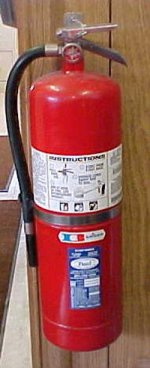
Type Here are the basics of fire extinguishers.
I There are Three Classes of Basic Fire Extinguishers:
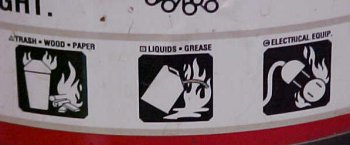
Class A = For wood, paper, cloth, and most plastics
Class B = For flammable liquids such as gas, oil, and solids.
Class C = For electrical
Most basic extinguishers put out the fire by starving the fire of oxygen.
II Types of Basic Fire Extinguishers
Dry Chemical - which is good for class A,B,C fires.
CO2 - which is good for B,C, and small class A fires.
Halon - which is good for small electrical fires like computers.
Dry Chemical extinguishers use Ammonia Phosphate or Potassium Chloride powder. These work well on A, B, and C type of fires, however, the powder needs to be cleaned up quickly after the fire because they are corrosive. These are OK to use in less ventilated areas.
CO2 extinguishers are carbon dioxide, which is like dry ice in a liquid / gas form. They cool the fire down quickly as well as starve the fire of oxygen. DO NOT USE this type in an area that is not well ventilated area. Also, do not touch the discharge horn after immediate use since it can cause burns to your skin just like dry ice.
Halon extinguishers are another type that cools the fire down quickly and starves the fire of oxygen. They are best used on computers since they leave no residue and cause damage to components. DO NOT USE this type in a area that is not well ventilated. Halon extinguishers that are over 9lbs can also be used on all three class of fires.
III Fighting Fires
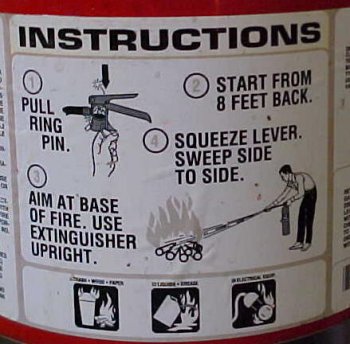
- Pull out the safety pin, aim nozzle at the bottom of the flame and spray.
- Fight fires from the bottom, never the flame. With a sweeping motion aim at the base of the flame and continue even after the flame has gone out.
- Never expect one extinguisher to do the job. While fighting the fire get someone (if possible) to go for a back up. If you need it, it will be there. If you do not need it simply put it back after the fire is completely out.
- Clean up the dry powder (if that type is used) after the site has cooled.
- STORAGE AND MAINTENANCE
- Always store your fire extinguishers in some type of secure bracket. Extinguishers are under pressure and like any compressed cylinders if the valve is broken off it will become a flying projectile. There are wall mounts where the extinguisher is hung on a hook or vehicle mounts that strap it in to keep it secure during vehicle operation.
- The proper location should be accessible in a hurry and not close to areas that are prone to fire, (i.e. closets next to the electrical panel, close to gas valves, next to stoves or under the hood of a vehicle). They should be located near these areas but not next to them.
- Ideally you should check you extinguisher monthly by inspecting the pressure gage to see that it is in the green. If it is not and it is below the green line get it serviced. Also, with dry-chem extinguishers you should turn them upside down once a year to help keep the powder fluid. If you hold it up to your ear you can hear the powder sifting like sand or moving in some type of fashion.
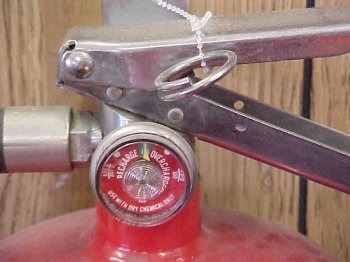
- DO NOT PAINT OVER RUST SPOTS
until you have had the extinguisher hydro tested. Dry-chem extinguishers should be hydro tested ever 12 years regardless, and 5 years on CO2 type.
- Never return extinguishers to storage if you have used
it without having it serviced first. Have it serviced ASAP. Even if you use just a squirt, the valve my not seal and have an extremely slow leak that will leave your extinguisher unpressurized when needed.
- Have you extinguishers inspected annually
by a extinguisher company. The fee is usually nominal and they can look for defects they the untrained eye will not catch.
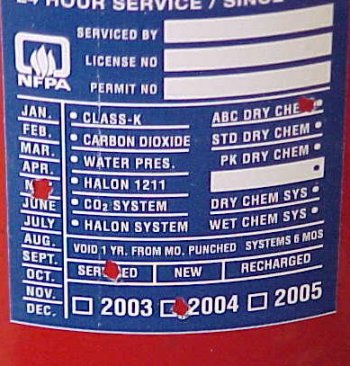
I hope you never have to use a fire extinguisher but if it is needed it is well worth the price when it saves your family, home, or BOV.
Good Luck,
Cody
www.alpharubicon.com
All materials at this site not otherwise credited are Copyright © 1996 - 2004 Trip Williams. All rights reserved. May be reproduced for personal use only. Use of any material contained herein is subject to stated terms or written permission.





